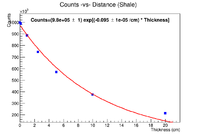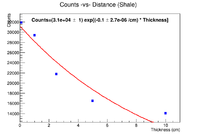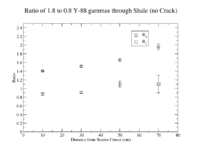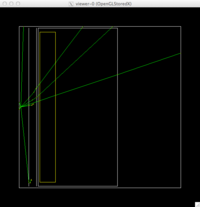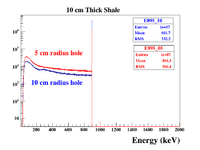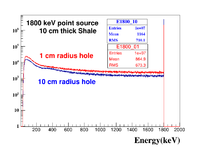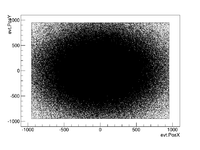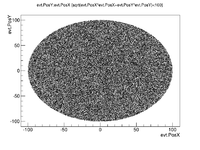TF IsotopeTracers4Cracks
Definition of Shale
Shale was assumed to have the chemical composition of
and a density of 2.6 g/
G4Element* O = new G4Element("Oxygen" , "O", z=8., a= 16.00*g/mole);
G4Element* Al = new G4Element("Aluminum" , "Al", z=13., a= 26.98*g/mole);
G4Element* Si = new G4Element("Silicon" , "Si", z=14., a= 28.085*g/mole);
G4Element* H = new G4Element("Hydrogen" , "H", z=1., a= 1.008*g/mole);
G4Material* Shale = new G4Material("Shale", density= 2.6*g/cm3, nel=4);
Shale->AddElement(Al, 15*perCent);
Shale->AddElement(Si, 15*perCent);
Shale->AddElement(O, 38*perCent);
Shale->AddElement(H, 32*perCent);
Photon Attenuation in Shale
According to the XCOM database, the attenuation length for a 1.8 MeV photon is 0.16 /cm and 0.895 is 0.22/cm through shale.
File:XCOM attenuation4Shale.pdf
Directing a 1.8 MeV beam of photons in GEANT4 towards various thicknesses of shale produced the graph below.
XCOM predicts an attenuation coefficient of 0.0441 cm^2/g which becomes 0.12/cm when you multiply by the shale density of 2.6 g/cm^3. The fit to GEANT4's predictions above produces a value of 0.1/cm when you plot the number of photons that pass through the shale and still have an energy of 1.8 MeV.
If I use a point source isotropically emitting 1800 keV photons I observe
which gives a the value of 0.1/cm as well.
Yittrium in Shale
A simulation of the penetration of the 0.895 and 1.8 MeV photons from Yittrium through shale.
GEANT4 create a point source or 895 keV photon and another with 1800 keV photons iostropically distributed.
A 4" thick piece of shale was placed between the source and the detector.
Two ratios were constructed.
Insert a single crack
A simulation was performed that predicted the transmission of photons through 10 centimeters of shale. The shale is in the form of a cylinder with a hole through the central axis.
The source was a uniform points source. One set of simulations used a 1.8 MeV photon and another used a 0.895 photon.
Energy distribution
Position Distribution
The Shale is a cylinder and the detector is a rectangle. A cut is used to look only at photons within the cylinder.
Units are Centimeters.
Rates
A uniform point source sent 10^7 photons of a specific energy in all directions.
1 Curie = decays/sec
Surface rates -vs- Crack size
The crack size decreases as you move from left to right in the table.
A projection is made along the X-axis with the cuts
- radius < 100 cm
- Energy > Source energy (0.7 or 1.7 MeV)
The result below is from a 1800 keV uniform point source and a 10 cm thick shale wall with a cylindrical hole through the center (X=0:Y=0)
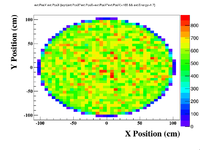 |
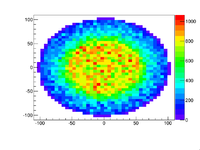 |
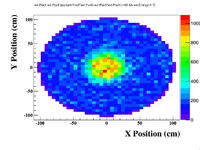 |
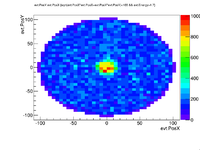 |
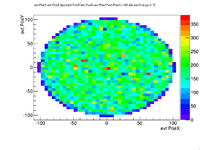
|
| 100 mm hole | 25 mm hole | 10 mm | 5 mm | 1 mm |
The result below is from a 895 keV uniform point source and a 10 cm thick shale wall with a cylindrical hole through the center (X=0:Y=0)
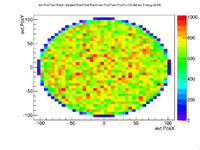 |
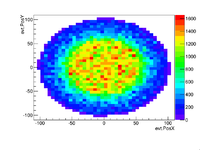 |
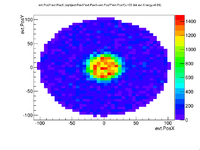 |
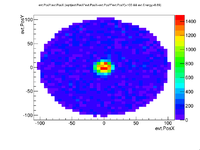 |
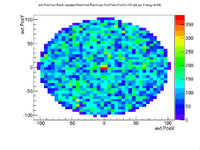
|
| 100 mm hole | 25 mm hole | 10 mm | 5 mm | 1 mm |
Now change the detector size from a 5 x 5 cm area to a 0.5 x 0.5 cm area.
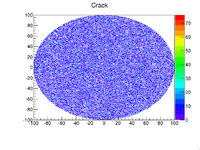 |
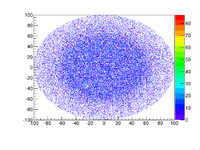 |
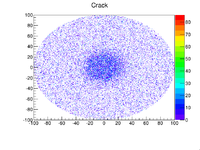 |
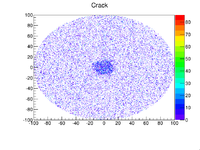 |
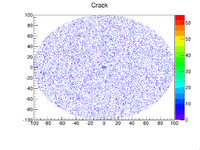
|
| 100 mm hole | 25 mm hole | 10 mm | 5 mm | 1 mm |
The result below is from a 895 keV uniform point source and a 10 cm thick shale wall with a cylindrical hole through the center (X=0:Y=0)
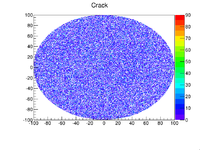 |
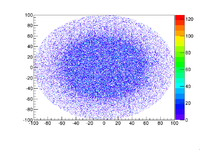 |
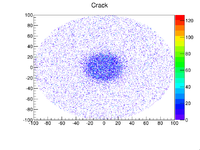 |
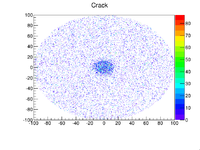 |
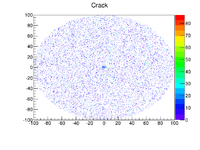
|
| 100 mm hole | 25 mm hole | 10 mm | 5 mm | 1 mm |
Projections
As observed above, the 1 mm radius hole may be observed if you use a detector that is 5 x 5 mm.
Notice that the 895 keV photons show a more distinct peak for the 1 mm radius holes than the 1800 keV photons. The bins are 2cm in size to represent a 2 cm x 2cm area detector. A cut was made restricting the Y-position to +/- 1 cm.
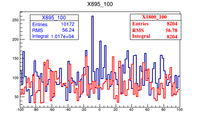 |
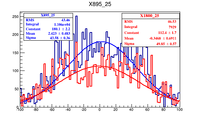 |
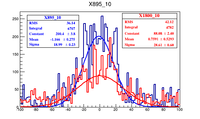 |
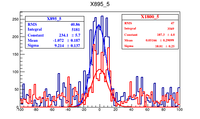 |
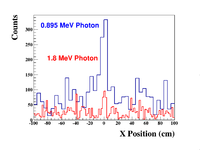
|
| 100 mm hole | 25 mm hole | 10 mm | 5 mm | 1 mm |
Peak ratio -vs- distance from center
The analysis below compares the number of photons at two energies of 0.895 and 1.8 MeV that penetrating the shale as a function of the distance from the radial center. A 2 x 2 cm detector is used.
sample root command
PhotonTrack->Draw("evt.Energy","sqrt(evt.PosX*evt.PosX+evt.PosY*evt.Poroot [27] abs(evt.PosY)<1 &&evt.PosX>0 && evt.PosX< 4 && evt.Energy>1.7");
| Distance (cm) | Energy | |||||||||||||||
| 100 mm hole | 25 mm hole | 10 mm | 5 mm | 1 mm | ||||||||||||
| 0.895 MeV | 1.8 | Ratio | 0.895 | 1.8 | Ratio | 0.895 | 1.8 | Ratio | 0.895 | 1.8 | Ratio | 0.895 | 1.8 | Ratio | ||
| 2 | 144 | 285 | 0.51 | |||||||||||||
